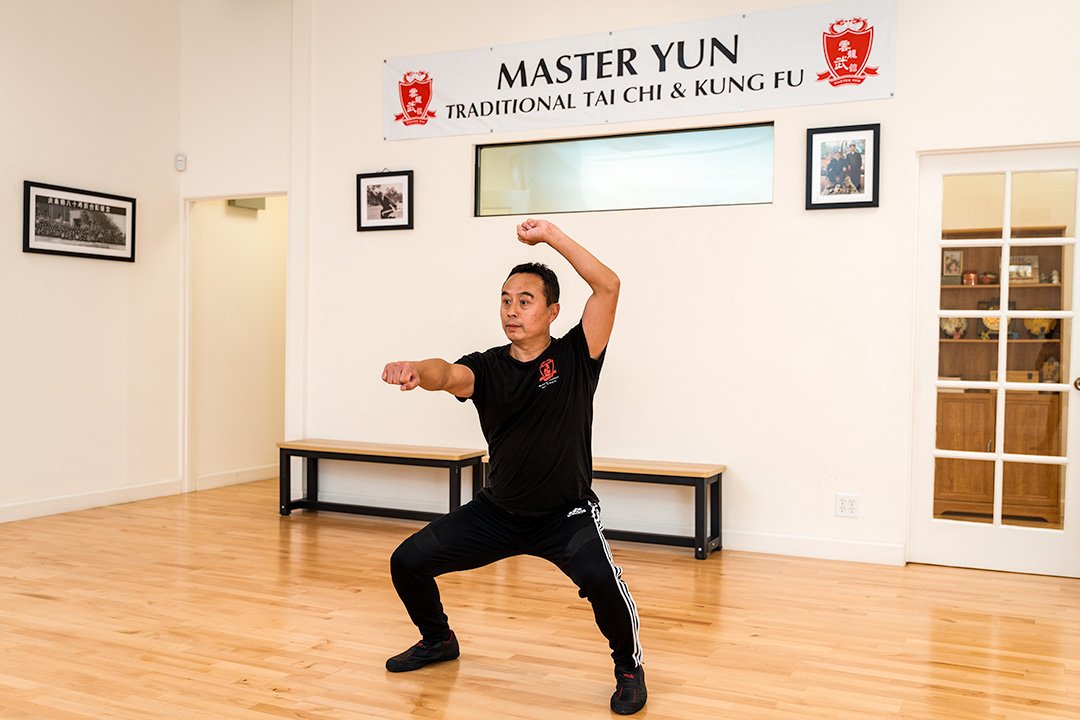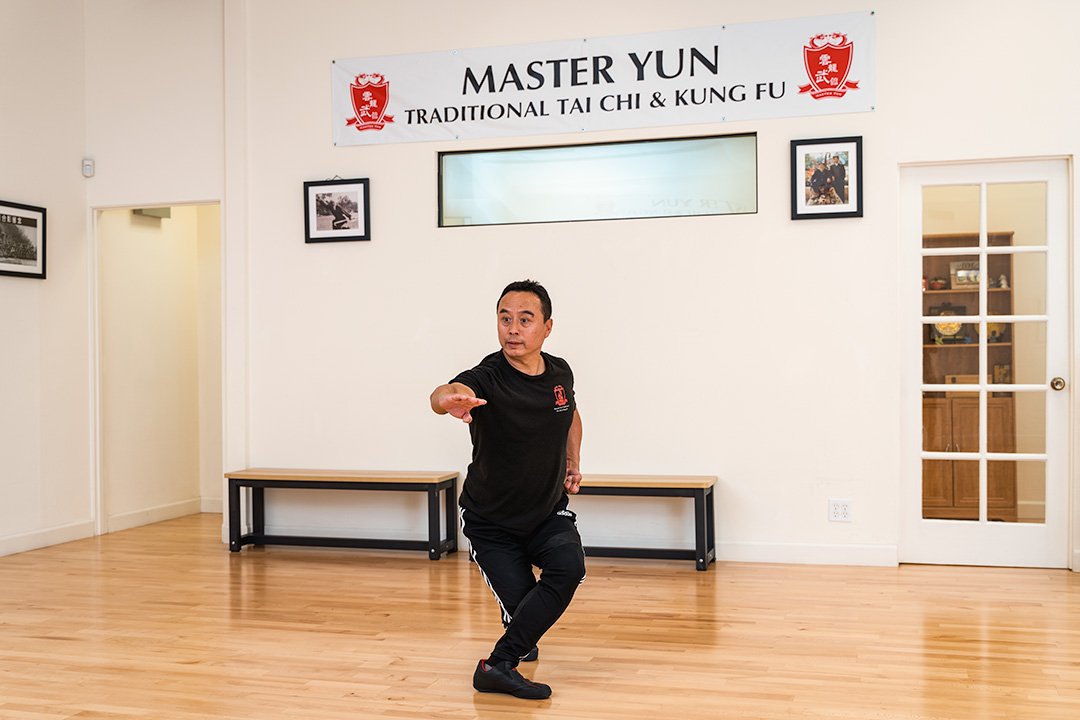Seven Star Praying Mantis Kung Fu
七星螳螂拳
SEVEN STAR PRAYING MANTIS KUNG FU
There are quite a few legends surrounding the creation of the Praying Mantis Form, however, during the Song Dynasty (960-1279) a consensus has been established that the Mantis Fist was first created by Master Wang Lang(王郎) at the request of Abbot Fu Ju (福居, 1203-1275) when he brought together eighteen masters to improve the martial arts of Shaolin. After the Song Dynasty fell much of the documentation was lost to the ages until a manuscript depicting the martial art forms was found in 1794. It is at this point where Master Yun can trace the history of his martial arts style that he now teaches in his studio.
CHARACTERISTICS
Seven Star Praying Mantis Kung Fu is an external martial art. It is known for its complex, rapid hand motions and mobile footwork. It is a complete Martial Art System, employing striking, kicking, grappling, joint locks, and traditional weapons training. In addition to self-defense, practicing 7 Star Praying Mantis will develop strength, flexibility, and coordination. It is an excellent system for all-around physical health.
interested IN LEARNING SEVEN STAR PRAYING MANTIS KUNG FU WITH MASTER YUN?
KUNG FU FUNDAMENTALS
Praying Mantis Kung Fu consists of several stances. We have created this primer as a resource for you to help practice and reinforce the fundamental stances that you will be learning in our kung fu classes. These stances should be practiced frequently.
In this video, Master Yun demonstrates a common routine to practice the fundamentals of kicking that are performed throughout traditional Chinese kung fu.
In order of appearance below the fundamental stances are: Gong Bu (Bow Stance), Ma Bu (Horse Stance), Jin Ji Du Li (Golden Rooster), Pu Bu (Crouching Stance), Shi Bu (Empty Stance), Zuo Pan (Crossed Sitting Stance), and Qi Lin.
Gong Bu:
Bow Stance
Ma Bu:
Horse Stance
Jin Ji Du Li:
Golden Rooster
Pu Bu:
Crouching Stance
Shi Bu:
Empty Stance
Zuo Pan:
Crossed Sitting
Qi Lin
HISTORY & LINEAGE OF SEVEN STAR PRAYING MANTIS KUNG FU
The particular style of Northern Praying Mantis Kung Fu Master Yun practices, and now instructs, is known as Seven Star Praying Mantis Kung Fu (七星螳螂拳; pinyin: qī xīng tángláng quán). This style of praying mantis is one of the best-known styles of the martial art, however, in China, it is mostly practiced in the Shandong and Liaoning Providences.
LI ZHIJIAN (李之箭; 1810-1891)
Li Sanjian, also known as: Li Zhijian and Li Kuaishou, was born in 1821 in Li family village, City of Pingdu, Shandong Province, China. Li Sanjian was a Security Logistics Officer (保鏢), but he was famous for his martial arts throughout China. He traveled and fought as far south as Fujian Province (893 miles from Pingdu) and as far north as Beijing (343 miles from Pingdu). During that time much of the China plains were in disarray by rebellious groups and the government had little control over the lawlessness in Zhili (Hebei) and Shandong, as a result guarding valuables across the country was no easy task. It is unclear of where he learnt Mantis Boxing, although legends proclaim that a wandering Daoist (Sheng Xiao Dao Ren) from Lao Mountain had taught him. After a lengthy combat career Li took only few major disciples, his nephew Li Taibao, Hao Shunchang, Wang Yongchun and Wang Yunpeng.
In 1888, Li Sanjian had visited his friend Li Yichun in Yantai. At that time he took on two disciples, Hao Shunchang (who went on to become the founder of Yuanyyang Tanglang Quan (鸳鸯螳螂拳 Mandarin Duck Kicks Mantis Boxing) and Wang Rongsheng (who went on to become the founder of Qixing Tanglang Quan (七星螳螂拳 7 Star Mantis Boxing). It was said that Hao Shunchang excelled in sets such as Dan Chahua, Shuang Chahua, Shibasuo, Guatui and Cuogang. Whilst Wang Rongsheng learnt sets such as Zhaiyao, Bazhou, Kuaishou and Tanglang Shou. Li Sanjian is said to have taught them for only 3 years. The two friends Hao and Wang mutually exchanged and thereafter Master Wang Rongsheng created the Seven Star Mantis System. Later Master Li Sanjian, he returned to his village, where his last disciple was young Wang Yunpeng.
WANG YUNPENG (王云鹏; 1875-1959)
Wang Yunpeng was Wang Qingzhai's master of Seven Star Praying Mantis. Here is a quick history of Wang Yunpeng ( 王云鹏, 1875-1959) (also known as Wang Yunfu and Wang Shaofei) from Pingdu, Shandong Province, studied with Wang Rongsheng (in another record it suggests Li Sanjian but given the content and structure of his materials it is likely Wang Rongsheng with influence from Lin Jingshan). In 1892 he studied Baguazhang under Ma Gui. In 1911 he went to Tianjin where he met with Lin Jingshan and the two exchanged skills. Some of his students include Wang Qingzhai, Wang Xiuhua, Liu Yufang, and Tian Bingzhang.
WANG QINGZHAI (王庆斋;1905-1993)
Wang Qingzhai was born in Jinzhou, Anqiu County, Shandong Province but grew up in Dalian, Liaoning province. He followed Zhang Chenggong and Sun Chengyun to study Digong Boxing and Chang Boxing. At the age of 16, he began to learn Seven Star Mantis Boxing from master Wang Yunpeng. In the 1930s, he studied Shaolin Mantis Boxing, Qing Ping Jian, and Luoshi Duanmenqiang from Master Sun Wenbo, during the time, he met Mr. Liu Zhonghe and obtained Wuzigong as his lifelong practice of martial arts. In the middle of the 1930s, Mr. Wang Qingzhai moved to Shenyang and opened a martial arts studio. In 1947, he won the top ten in the Northeast Martial Arts Competition.
ZHANG YUNCHAO | MASTER YUN (张云超)
This is where the history and lineage meet today in our studio with Master Yun teaching this martial art to the next generation.





























In this video, Master Yun demonstrates a common routine to practice the fundamentals of kicking that are performed throughout traditional Chinese martial arts